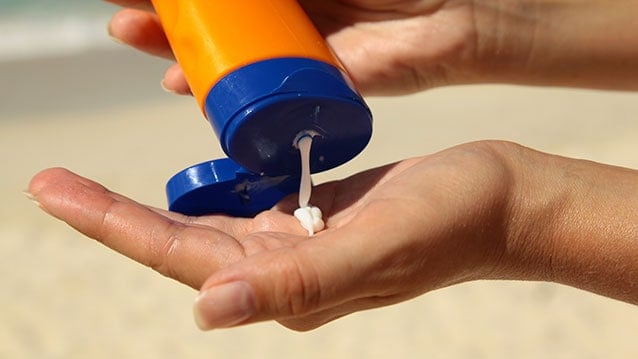In a perfect world, people would diligently reapply suncreen every couple of hours to protect their delicate skin from damaging solar radiation. But in reality, few people actually adhere to reapplication guidelines, and those who do hardly relish the task. To develop longer-lasting sunscreens, researchers are trying to answer a basic question: How do sunblock ingredients work?
The researchers will present their work today at the 253rd National Meeting & Exposition of the American Chemical Society (ACS). ACS, the world’s largest scientific society, is holding the meeting here through Thursday. It features more than 14,000 presentations on a wide range of science topics.
“Sunscreens have been around for decades, so you’d think we know all there is to know about them — but we really don’t,” Vasilios Stavros, Ph.D., says. “If we better understand how the molecules in sunscreen absorb light, then we can manipulate the molecules to absorb more energy, and we can protect the molecules from degradation. If the molecule doesn’t break down, there’s no need to reapply.”
A typical sunscreen sold at a drug store contains many different ingredients, Stavros explains. “We wanted to break these lotions and creams down like a jigsaw puzzle — take one of the ingredients and understand it from a molecular point of view without interactions from the other component parts.”
The researchers, who are at the University of Warwick (U.K.), started by focusing on sunscreen ingredients called chemical filters, which are molecules that absorb UV light. They have studied about 10 common chemical filters so far. When these molecules absorb energy from the sun, Stavros explains, they enter into an excited electronic state. Other molecules are likely to break under the sun’s glare, sometimes releasing dangerous free radicals. But instead of breaking, chemical filters can shimmy and shake themselves back into the more stable ground state, releasing energy as harmless heat. The problem is that these chemical filters can fail, breaking into pieces or getting stuck in the excited state.
To figure out how to prevent chemical filter dysfunction, Stavros’ team used lasers to simulate the sun’s energy and to monitor the flow of energy through the chemical filters as the molecules traverse from the ground state to the excited state and back again (or not). For example, the researchers found that about 10 percent of the molecules of the sunscreen ingredient oxybenzone get locked in an excited state when the laser is shone on them. “When that chemical filter is in an excited state, its atoms are rotating around certain bonds,” Stavros says. “If we can manipulate this rotation by adding different chemical groups, we could help the molecule find its way back to the ground state,” he says, noting that they plan to work on this project soon.
In addition, the researchers are beginning to study the filters in a context that is more similar to an actual sunscreen, rather than in isolation. “We are increasing molecular complexity, building the jigsaw puzzle,” Stavros says. He adds that analyzing the data has been a challenge, but one that the team is tackling head-on. In the end, the data analyses and chemical manipulations should shed more light on how sunscreens protect against sun damage so researchers can develop longer-lasting concoctions.



Correction – I meant oxybenzone.
What is more important is getting ingredients that (unlike oxycodone) are not toxic to marine life. Oxycodone is especially toxic to corals and screens containing it should not be used at all in tropical areas. It is also toxic (but less so) to other marine animals.